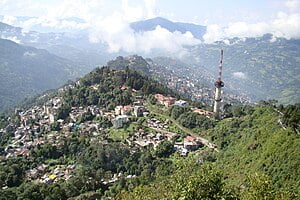No products in the cart.
SIKKIM—Knocking at Heaven’s Door
he grand Himalayan vistas, its fabulous forested enclaves, history, heritage, and rich culture—and its towns and villages abrim with friendly folk, make Sikkim one of India’s most alluring holiday destinations
The Lepcha community, its original inhabitants got it spot-on when they named their land ‘Nye-mae-el lang’—the abode of the Gods. Demazong, or ‘the Valley of Rice’, as the Bhutia called this ancient land, embraces the upper valley of the Teesta River, a major tributary of the Brahmaputra River. Sikkim’s 7,096-km sprawl, where it nestles alongside West Bengal in its southern reaches, is watered by the Rangit and Rangpo. Separated from Nepal in the north by the Singalila Range, it is protected by the serried ranks of the Dongkhya Range running along the borders from the north to the northeast.
This self-contained world has revealed its treasures sparingly to the world’s travelling community. Today Sikkim ranks as one of the most exciting nature -culture-adventure destinations in the world.
The early history of Sikkim is shrouded in the mists of mystery, but what we do know is that it was originally inhabited by the Lepchas. The region became a playground for rival clans from Tibet, amongst them the Namgyals, who steadily gained ground and in the 1400s continued to push everyone else out. From 1642 to 1975 this ancient kingdom was ruled by the Chogyals, the monarchs who were descendants of Tibet’s royal Namgyal Dynasty. The pretty town of Yuksom was the first capital of the Chogyals when Phuntsog Namgyal, a young prince who descended from Guru Tashi in Tibet’s Kham region, laid his claim to the kingdom—and created a path for 11 more Chogyals to rule the land over time.
During the skirmishes which ensued with neighbouring Nepal and Bhutan in the 1700s, Sikkim lost a lot of its territories. This period also saw the arrival of the Nepalese who settled down here as farmers. Things became more complicated with the interventions of the British in the region. Sikkim, having sided with them against Nepal (1814-1815), even managed to get back some of its lost lands. Despite its tough stance Sikkim, however, was unable to resist coming under British rule in 1861. Eventually the British established a political office to assist the Chogyal in running the kingdom. Having gained its independence from colonial rule, Sikkim later declined becoming part of Independent India. In 1975 Palden Thondup, the last Chogyal, ceded the kingdom to India, thus ending Sikkim’s status as a monarchy.
Steeped in myths and mysticism this ancient kingdom offers deeply immersive cultural experiences against the backdrop of some of Earth’s most gorgeous natural settings. Visitors will be enthralled by the rapturous charms of its snowclad pinnacles, tranquil lakes, and forestlands of great botanical wealth and exotic wildlife. Up-close and personal connections with the land and the people hold the promise of providing visitors with some of the most memorable cultural experiences to take home.
Heli tours, trekking, river rafting, mountain biking, visits to shrines and monasteries, indulgent culinary experiences, and shopping for local crafts are just half the story. There’s so much else to discover to inspire many more trips in the years to come.
Rewarding experiences can be enjoyed at Nathu La and Tsongo Lake, the Rumtek Monastery, Khecheopalri (wishing) Lake, the trekking routes of Pelling, Yuksom, Maenam, and Yumthang Valley—and those unmissable festivals full of colour and pageantry. Special helicopter tours offer aerial explorations of West Sikkim and North Sikkim with their monasteries and mountain vistas, along with that exotic Valley of Flowers—Yumthang.
Air connectivity is available at Pakyong Airport, the first airport of Sikkim, located in Pakyong village, 35kms south of Gangtok. The gateway town of Siliguri, in the plains of the Dooars of West Bengal, offers air connectivity via Bagdogra Airport. Bagdogra is also connected with Gangtok by daily helicopter (20 mins) service operated by Sikkim Tourism Development Corporation. Siliguri and New Jalpaiguri are the nearest railheads. The drive up from Siliguri to the state capital Gangtok via the stunning Teesta gorge is mind-blowing.
















